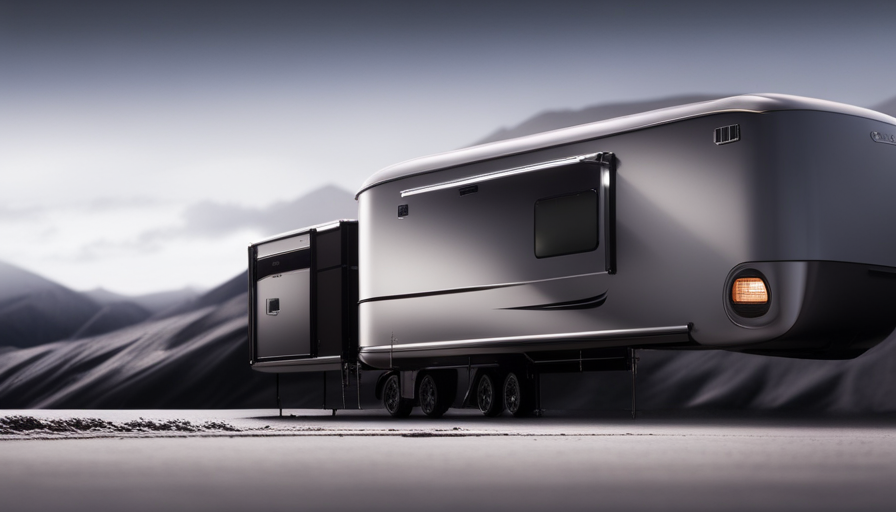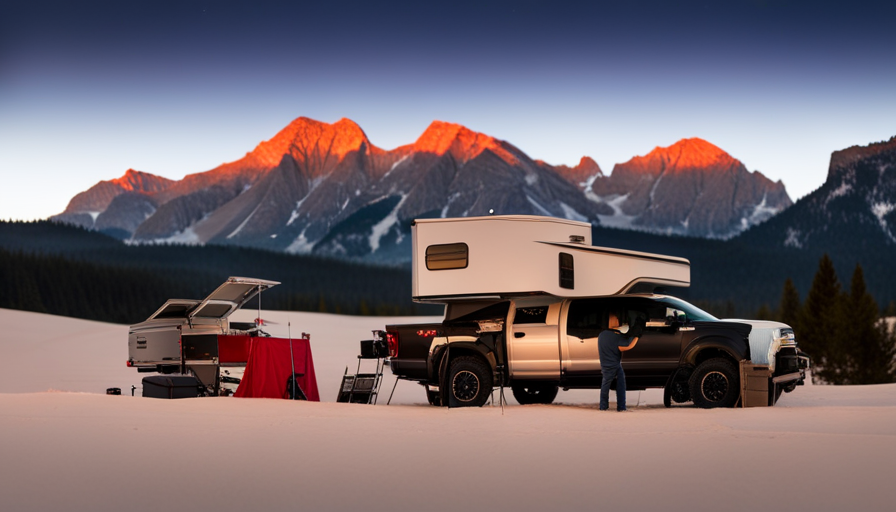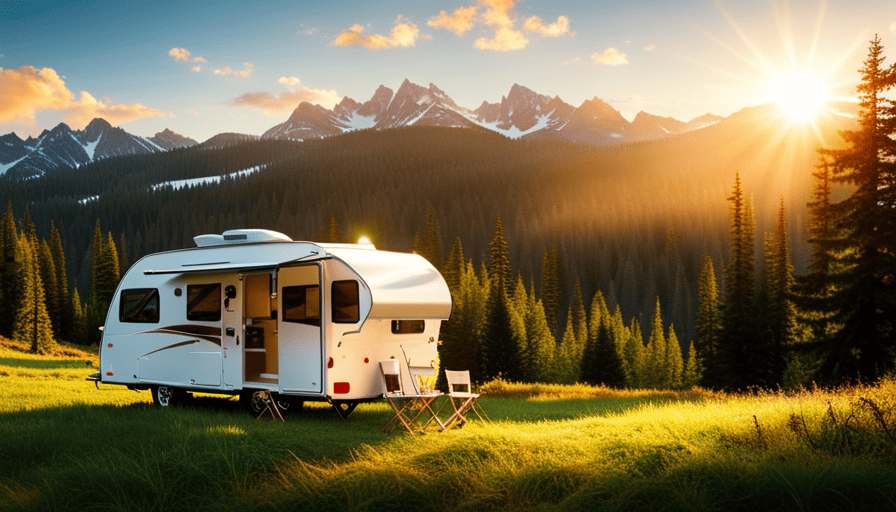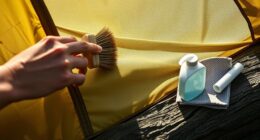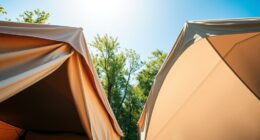Did you know that the construction of a camper’s exterior walls plays a crucial role in the camper’s durability and functionality? The materials chosen can have a significant impact on the longevity and performance of your RV. With that in mind, let’s explore the fascinating world of camper exterior walls and take a closer look at the different materials commonly used in their construction.
According to industry research, fiberglass is the most popular material used for camper exterior walls, accounting for approximately 60% of the market share. This lightweight and durable material offers excellent insulation properties and is resistant to moisture and temperature fluctuations.
Another commonly used material is aluminum, known for its strength and corrosion resistance. Wood, composite panels, and steel are also utilized, each offering their own unique advantages.
Furthermore, polystyrene, fiberglass reinforced panels (FRP), composite wood, and high-density polyethylene (HDPE) are materials that have gained popularity in recent years due to their lightweight nature and enhanced insulation properties.
Understanding the materials used in camper exterior walls will help you make an informed decision when it comes to purchasing or renovating your own camper. Let’s explore these materials in more detail and discover which one is best suited for your needs.
Key Takeaways
- Fiberglass is the most popular material for camper exterior walls, offering excellent insulation and resistance to moisture and temperature fluctuations.
- Aluminum is commonly used for camper walls due to its strength, corrosion resistance, and low maintenance requirements.
- Wood, composite panels, and steel are also used for camper walls, each providing unique advantages such as customization options, impact resistance, and security.
- Lightweight materials like polystyrene, FRP, composite wood, and HDPE are gaining popularity for their insulation properties, fuel efficiency, and resistance to impacts, chemicals, and weathering.
Fiberglass
The camper’s exterior walls are typically made of fiberglass, providing durability and insulation. Fiberglass is a lightweight material composed of fine fibers of glass. These fibers are woven together to create a strong and flexible structure that can withstand various weather conditions.
One of the main advantages of fiberglass is its excellent insulation properties. It helps to maintain a comfortable temperature inside the camper, keeping it warm in cold weather and cool in hot weather.
In addition to its insulation properties, fiberglass is also known for its low maintenance requirements. It’s resistant to rot, corrosion, and damage from UV rays. This means that camper owners don’t have to worry about frequent repairs or replacements. Regular cleaning with mild soap and water is usually enough to keep fiberglass walls looking clean and new.
Transitioning to the subsequent section about aluminum, it’s worth mentioning that while fiberglass is a popular choice for camper exteriors, aluminum is another common material used in construction. Aluminum offers its own set of advantages, including lightweight construction and high resistance to corrosion.
Aluminum
Aluminum, our camper’s protective armor, gleams like a silver shield against the elements. Aluminum trailer construction has become increasingly popular due to its numerous benefits.
One of the main advantages of aluminum walls is their durability. Unlike other materials, aluminum is resistant to rust and corrosion, making it ideal for withstanding harsh weather conditions. Additionally, aluminum is lightweight yet sturdy, allowing for improved fuel efficiency and easier maneuverability on the road.
Another benefit of aluminum walls is their low maintenance requirements. Unlike fiberglass or wood, aluminum doesn’t require frequent painting or sealing to maintain its appearance and structural integrity. This not only saves time and effort but also reduces long-term costs.
Furthermore, aluminum walls offer excellent insulation properties. They can help regulate the temperature inside the camper, keeping it cool in the summer and warm in the winter. This creates a comfortable and enjoyable camping experience regardless of the weather conditions outside.
Transitioning into the subsequent section about wood, it’s important to consider alternative materials for camper exterior walls. While aluminum provides excellent protection and durability, wood offers its own set of advantages that are worth exploring.
Wood
Consider using wood for your camper’s exterior for a touch of timeless elegance and natural beauty. Wood construction has been a popular choice for camper wall materials due to its durability and aesthetic appeal. The use of wood in camper exteriors provides a warm and inviting ambiance, creating a cozy living space while on the road.
When it comes to camper wall materials, wood offers several advantages. Firstly, it’s a renewable resource, making it an environmentally friendly option. Additionally, wood provides excellent insulation properties, helping to regulate the temperature inside the camper and reducing energy consumption. This can be especially beneficial during extreme weather conditions.
Wood construction also allows for customization and personalization. Different types of wood can be used, such as cedar or pine, each offering unique characteristics and appearances. Additionally, wood can be stained or painted to match your personal style and taste.
However, it’s important to note that wood requires regular maintenance to protect it from moisture and other elements. Proper sealing and periodic inspections are necessary to ensure the longevity of the camper’s exterior.
Transitioning to the subsequent section about composite panels, these alternatives offer a lightweight and durable option for camper exteriors.
Composite Panels
Looking for a modern and practical option for your camper’s walls? Composite panels are a lightweight and durable choice that will elevate your camper’s style and functionality. Made from a combination of materials, such as fiberglass, aluminum, and foam, composite panels offer several advantages.
Firstly, they are incredibly strong and resistant to impact, making them ideal for withstanding the rigors of outdoor travel. Secondly, their lightweight nature contributes to fuel efficiency, allowing you to save on costs during your trips. Additionally, composite panels provide excellent insulation, keeping your camper comfortable in both hot and cold weather conditions.
However, it is important to consider some disadvantages of composite panels as well. While they are durable, they can be more expensive than other wall materials, which might impact your budget. Moreover, due to the complexity of their construction, repairing or replacing composite panels can be challenging and costly. It is also worth noting that composite panels may not offer the same level of sound insulation as other materials.
Despite these drawbacks, composite panels remain a popular choice among camper enthusiasts due to their modern aesthetic and functional benefits.
Transitioning into the subsequent section about steel, it is important to explore alternative options for camper exterior walls.
Steel
Steel is a strong and durable option for camper walls, providing excellent protection and security. Here are three key reasons why steel construction is a popular choice for camper exteriors:
-
Strength: Steel is known for its exceptional strength, making it highly resistant to impact and external forces. This strength ensures that camper walls made of steel can withstand harsh weather conditions and potential accidents on the road.
-
Durability: Steel walls are built to last. They’re resistant to rust, corrosion, and degradation, ensuring longevity and reducing the need for frequent repairs or replacements. This makes steel a cost-effective option for camper owners in the long run.
-
Low Maintenance: Steel walls require minimal maintenance compared to other materials. They’re easy to clean and don’t require special treatments or coatings to maintain their integrity. This means less time and effort spent on maintenance, allowing campers to focus on enjoying their adventures.
Transitioning into the subsequent section about ‘vinyl’, it’s worth considering another popular choice for camper exteriors.
Vinyl
Imagine yourself standing in front of a camper with vibrant vinyl siding, adding a touch of charm and personality to your outdoor adventures. Vinyl is a popular choice for camper exterior walls due to its durability and low maintenance requirements.
The vinyl used in camper siding is specially designed to withstand the harsh elements of the outdoors, including rain, snow, and UV radiation. This ensures that the siding remains intact and retains its vibrant color for years to come.
One of the key advantages of vinyl siding is its durability. It’s resistant to dents, scratches, and fading, making it a long-lasting option for camper exteriors. This means that you won’t have to worry about frequent repairs or replacements, saving you time and money in the long run.
In terms of maintenance, vinyl siding is relatively low maintenance compared to other materials. It’s easy to clean and only requires occasional washing with a mild detergent and water to remove dirt and debris. Additionally, vinyl is resistant to moisture, so you don’t have to worry about mold or rot developing on your camper’s exterior walls.
As we transition into the subsequent section about ‘polystyrene’, it’s important to note that vinyl siding offers great protection and aesthetics for your camper, but there are other materials used in camper construction that contribute to its overall strength and insulation.
Polystyrene
Polystyrene is a material commonly used in camper exterior walls due to its lightweight and insulating properties. It offers excellent thermal insulation, helping to keep the interior temperature comfortable in different weather conditions. Additionally, polystyrene is resistant to moisture and mold, making it a suitable choice for outdoor applications.
However, it’s important to note that polystyrene can be prone to dents and scratches, so proper care and maintenance are necessary to preserve its appearance and functionality.
Lightweight and insulating
To make your camper as lightweight and insulating as possible, consider the versatile materials used for its exterior walls. Lightweight materials are crucial for enhancing fuel efficiency and reducing the overall weight of the camper, allowing for easier towing and maneuverability. These materials are specifically chosen for their excellent thermal insulation properties, helping to maintain a comfortable interior temperature regardless of the external weather conditions.
By utilizing advanced insulation techniques, camper manufacturers can optimize energy efficiency, reducing the need for excessive heating or cooling. Additionally, the insulating properties of these materials contribute to noise reduction, creating a quiet and peaceful environment inside the camper.
Another advantage of these lightweight materials is their resistance to moisture and mold, ensuring the durability and longevity of your camper. This moisture resistance will be further discussed in the subsequent section.
Resistant to moisture and mold
With materials resistant to moisture and mold, you can relax and enjoy your camper without worrying about potential damage or health risks.
Camper exterior walls are constructed using moisture resistant materials that prevent water from seeping through and causing damage. These materials are typically designed to repel water, such as fiberglass or aluminum siding. They’re also treated with special coatings that provide an extra layer of protection against moisture. This not only helps to prevent water damage but also inhibits the growth of mold and mildew.
By using moisture resistant materials, camper manufacturers ensure that the walls are durable and long-lasting. However, it’s important to note that while these materials are resistant to moisture and mold, they can still be prone to dents and scratches, which we’ll discuss in the subsequent section.
Can be prone to dents and scratches
While camper exterior walls are designed to be resistant to moisture and mold, they can be prone to dents and scratches. These imperfections may occur due to various factors, such as accidental impacts or environmental conditions. It is important to note that the material used for camper walls can vary, and this can affect their durability and impact resistance.
Different types of walls, such as aluminum or fiberglass, offer varying levels of protection against dents and scratches. Aluminum walls, for example, are generally more prone to dents, while fiberglass walls tend to be more resistant. Understanding these differences in durability and impact resistance can help campers make informed decisions when choosing the right material for their camper exterior walls.
Transitioning into the subsequent section, let’s explore the benefits of fiberglass reinforced panels (FRP).
Fiberglass Reinforced Panels (FRP)
Fiberglass Reinforced Panels (FRP) provide a durable and lightweight material for camper exterior walls. FRP is composed of a fiberglass mat that’s saturated with a thermosetting resin and then cured under high heat and pressure. This process creates a strong and rigid panel that’s resistant to dents and scratches, making it an ideal choice for the exterior of a camper.
One of the advantages of FRP is its high strength-to-weight ratio. It offers excellent structural integrity while keeping the overall weight of the camper low. This is important for fuel efficiency and towing capacity.
Additionally, FRP is highly resistant to moisture, making it a suitable choice for outdoor applications where exposure to rain and humidity is common.
However, there are some disadvantages to using FRP for camper exterior walls. Firstly, it can be more expensive compared to other materials such as aluminum or composite wood. Secondly, FRP may require periodic maintenance, such as waxing and polishing, to maintain its appearance and prevent degradation from UV exposure.
Transitioning to the subsequent section about composite wood, it’s important to consider alternative materials that offer different benefits and drawbacks for camper exteriors.
Composite Wood
After discussing the benefits of Fiberglass Reinforced Panels (FRP) for camper exterior walls, let’s move on to another commonly used material in the industry: Composite Wood.
Composite wood is a combination of wood fibers and a synthetic resin, resulting in a durable and versatile material. One of the main advantages of using composite wood for camper exterior walls is its high strength-to-weight ratio. This means that it provides excellent structural support while being relatively lightweight, allowing for better fuel efficiency and easier towing.
Additionally, composite wood is resistant to rot, decay, and insect infestation, making it a long-lasting option for outdoor use. However, like any material, composite wood also has its drawbacks. It can be prone to fading and discoloration when exposed to prolonged sunlight, requiring regular maintenance to keep its appearance intact. Moreover, composite wood may not be as impact-resistant as other materials, potentially leading to damage in case of accidents or rough handling.
As we move forward to the section on ‘high-density polyethylene (HDPE),’ we will explore another fascinating material used in camper exterior walls.
High-Density Polyethylene (HDPE)
High-Density Polyethylene (HDPE) offers a unique combination of durability and flexibility, making it a popular choice for constructing camper exteriors. When it comes to camper exterior wall durability, HDPE stands out due to its exceptional resistance to impact, chemicals, and weathering.
Here are three key benefits of high-density polyethylene (HDPE) walls:
-
Superior Strength: HDPE walls provide excellent structural integrity, ensuring that the camper can withstand various external forces such as wind, rain, and even minor collisions. This strength contributes to the overall durability and longevity of the camper.
-
Lightweight Design: Despite its robust nature, HDPE is surprisingly lightweight. This feature is advantageous for campers as it allows for more fuel-efficient towing and easier maneuverability on the road.
-
Flexibility: HDPE walls have a certain degree of flexibility, which helps absorb shocks and impacts, reducing the risk of damage to the camper. Additionally, this flexibility allows for easier installation and repairs, saving time and money.
The benefits of high-density polyethylene (HDPE) walls for camper exteriors are undeniable. Their durability, lightweight design, and flexibility make them an ideal choice for camping enthusiasts looking for a long-lasting and reliable camper.
Frequently Asked Questions
How do camper exterior walls compare in terms of durability and longevity?
When it comes to durability comparisons and longevity considerations, camper exterior walls are a crucial factor to consider. These walls are designed to withstand the elements and provide a sturdy barrier against external forces. They are typically constructed using high-quality materials such as fiberglass, aluminum, or composite panels. These materials offer excellent strength and resistance to wear and tear, ensuring that camper walls can endure the test of time.
Are there any specific maintenance requirements for different types of camper exterior walls?
Different types of camper exterior walls have specific maintenance requirements due to the use of common materials. Regular inspection and cleaning are essential to prevent damage and ensure longevity.
Fiberglass walls may require periodic waxing and polishing to maintain their luster.
Aluminum walls may need to be washed regularly to prevent corrosion.
Wood-based walls should be treated with sealant to protect against moisture and rot.
Adhering to these maintenance requirements will help extend the life of camper exterior walls.
Can camper exterior walls be easily repaired or replaced if damaged?
Repairing camper exterior walls can be relatively easy depending on the extent of the damage. Minor scratches or dents can often be fixed using simple DIY techniques such as filling and sanding. However, more severe damage may require professional assistance and could involve replacing sections of the wall.
The cost of replacing camper exterior walls can vary depending on the type of material used, the size of the damaged area, and the labor involved.
Are there any insulation benefits associated with certain types of camper exterior walls?
Certain types of camper exterior walls offer insulation benefits due to the materials used. A materials comparison reveals that walls made of fiberglass or foam insulation, such as polystyrene or polyurethane, provide excellent thermal resistance. These materials effectively reduce heat transfer, keeping the interior temperature stable.
The insulation benefits of these walls make them energy-efficient and ideal for use in various climates. Additionally, they contribute to a comfortable and cozy camping experience.
Do different types of camper exterior walls have an impact on the overall weight and towing capacity of the camper?
Different types of camper exterior walls can indeed have an impact on the overall weight and towing capacity of the camper. Heavier walls, such as those made of solid wood or metal, can increase the weight of the camper, reducing its towing capacity and potentially impacting fuel efficiency.
On the other hand, lighter materials like fiberglass or aluminum can help reduce the weight, increasing towing capacity and potentially improving fuel efficiency. It’s important to consider these factors along with cost comparisons when choosing camper exterior walls.
Can Camper Exterior Walls Support DIY Curtains?
Yes, camper exterior walls can support DIY curtains. When making curtains for camper, consider using lightweight fabrics and adhesive hooks to minimize any damage to the walls. Be sure to measure and install the curtains securely to ensure they stay in place while on the road.
Conclusion
After exploring the various materials used in camper exterior walls, it’s clear that there is no one-size-fits-all solution. Each material has its own unique advantages and disadvantages.
From the durability of fiberglass to the lightweight nature of aluminum, there are trade-offs to consider. However, one material stood out to me as a metaphor for resilience and adaptability: composite wood. Just like composite wood combines different materials to create a strong and versatile product, campers require a combination of qualities to withstand different weather conditions and provide a comfortable living space.
This serves as a reminder that life, like camper walls, often requires a blend of strengths to navigate the challenges that come our way.

